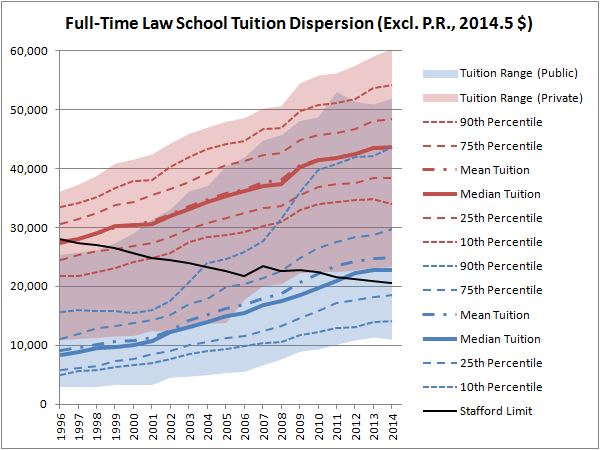Students at Atlanta’s John Marshall Law School were surprised to find their tuition was free for the 2014-15 academic year.
Such generosity!
That’s the most amusing error in the law school 509 Information Reports I’ve found thus far. The ABA doesn’t audit the data law schools provide it, so people using them might want to know when it’s obviously incorrect. I’m tallying up the ones I find, but I won’t do so exhaustively. I figure the ABA just runs a program that spits all the data into the reports automatically, so I’ll confine my teasing to the schools for the mistakes.
Atlanta’s John Marshall is one of two law schools that have tuition problems. For those curious, looking on John Marshall’s Web site I get $38,100 in tuition costs, $198 technology fees, $1,340 for health insurance, and $194 in student bar association costs ($39,832 total). This is largely consistent with its charges last year ($39,578).
Another law school with a tuition typo is St. Mary’s, whose 509 report says it charges $33,100 for resident and $33,110 for non-residents, a patent ambiguity that doesn’t make sense for a private law school. Worse, when I look at its Web site, I get $33,010 ($32,340 for tuition, $670 for fees). That’s the number I’m going to go with.
Readers might also be curious about law schools’ enrollment breakdowns. I don’t track the ethnicities of full-time and part-time students, but I did do get their totals as well as the genders and ethnicities of 1Ls, total enrollments, and graduates. These numbers usually add up across the table, but there are a few cases that I’ve found that don’t.
The biggest offender is SUNY-Buffalo, which accidentally totaled its male and female students in its “Other” column (a new addition to the reports this year) instead of the “Total” column. This causes significant arithmetical errors that end up doubling the school’s enrollment over the year before. I have SUNY-Buffalo with 547 full-time students, 10 part-time students, and zero “other” students.
The tables for San Francisco and Minnesota also do not total properly due to problems in the “Other” column. As I have it, San Francisco has 425 full-time students, 102 part-time students, and no “other” students (by enrollment, not gender). Minnesota has 681 full-time students, 17 part-time students, and zero “other” students (ditto).
It’s unclear, but I think most law schools that used the “other” category meant it for gender and enrollment status while these schools had one category but not the other.
Hopefully these errors will be corrected either by the law schools or the ABA.
**********
While I have your attention, I thought I’d spill the beans on where undiscounted tuition costs went this year: pretty much nowhere. The median private law school charged about $200 more than last year in real dollars, but costs are moving up slightly on the very high end while nominal tuition cuts are manifesting at the low end of the scale. I can’t make a clear determination at this point, but anyone thinking that legal education is moving toward a two-tier market—one for cheaper law schools, the other for very expensive prestigious ones—might see this as year 1 for their hypothesis.
I suppose now’s the appropriate time to congratulate Columbia for being the first law school to breach the $60,000 mark. 23 others charge more than $50,000 annually, many of them are in U.S. News‘ top 20. In 2010, only three charged so much.
The next chart shows the overall slowdown of tuition cost growth over the last few years and the nominal declines within the lowest quintile.

I haven’t done a full analysis yet, but I think only Iowa has seen any direct correlation between nominal cost cuts and an increase in applications (and that’s a public law school). The rest still saw declines.
Peace out.


7 comments